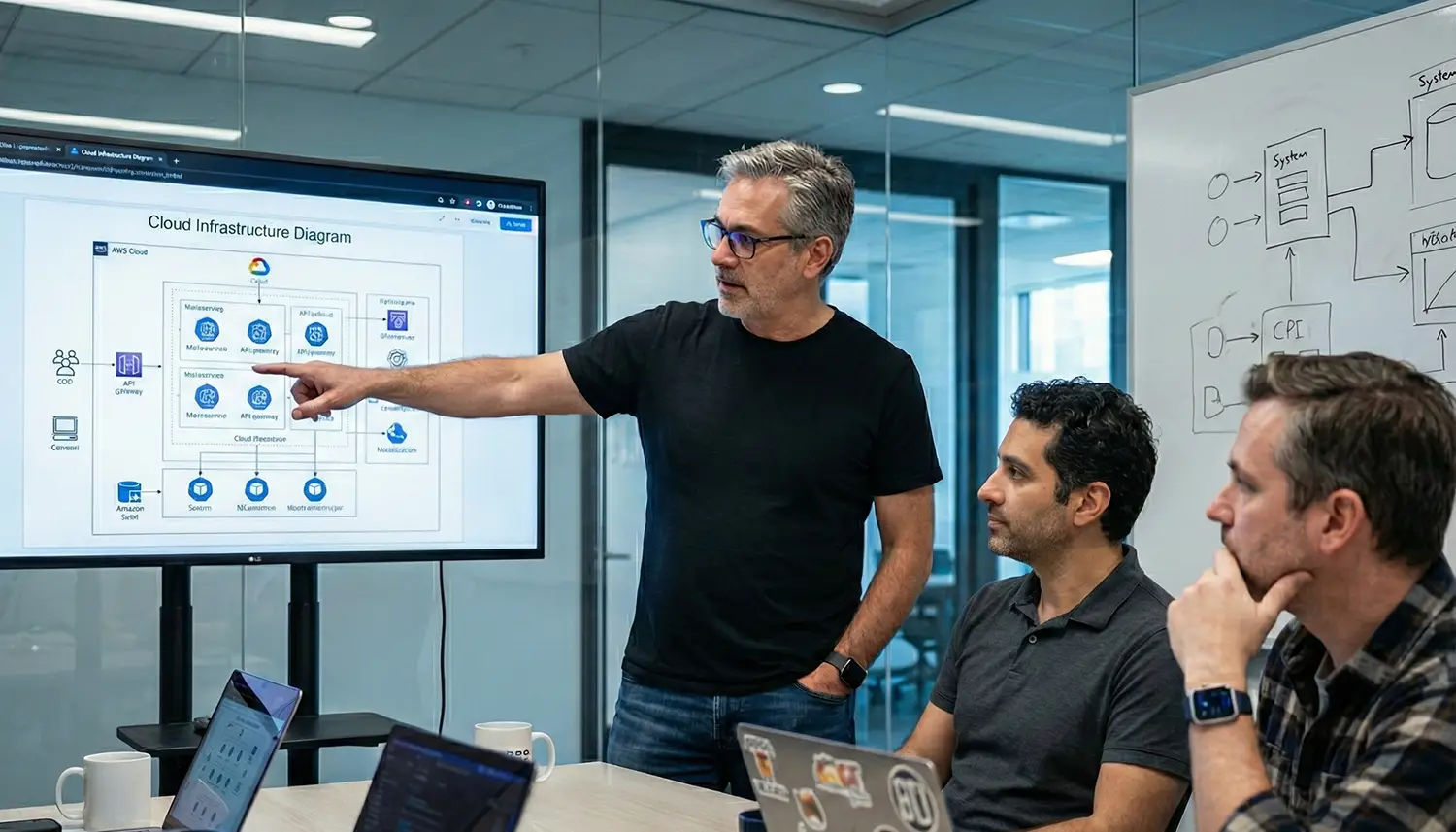Cloud-native platforms, machine learning, edge computing — the digital landscape is evolving at breakneck speed. But the ability to innovate doesn’t just depend on vision anymore — it hinges on access to the right talent, the right tools, and the right partners.
That’s why IT outsourcing has transformed. It’s no longer a reactive move to reduce costs. It’s a proactive strategy to scale smarter, respond faster, and embed intelligence across your business.
Here’s what’s driving this shift — and how today’s tech leaders are making the case for smarter outsourcing.
8 IT Outsourcing Trends Driving the Boom
- Talent Shortages Are Driving Demand for Scalable Expertise
76% of IT employers report difficulty hiring skilled professionals.
Rising demand for cloud, AI/ML and edge computing has outpaced the supply of qualified talent. Outsourcing now functions as a gateway to specialized skills and elastic delivery models that internal teams can’t match.
- Cybersecurity Outsourcing Becomes Non-Negotiable
77% of enterprises outsource cybersecurity functions.
With the average organization facing nearly 1,900 cyberattacks per quarter and breach costs rising sharply, internal teams are often stretched beyond their limits. Outsourcing to Managed Security Service Providers (MSSPs) delivers 24/7 coverage, specialized threat detection and compliance controls that most organizations can’t sustain on their own.
- AI Is Now Embedded in Outsourced Functions
83% of executives now use AI in their outsourced services.
We’ve entered the age of outsourcing with intelligence. From predictive analytics to autonomous workflows and fraud detection, AI is being woven into outsourced functions across every major vertical. The benefits go from accelerated AI adoption, lower risk and faster ROI to smarter decision-making and scalable learning systems.
- LatAm Nearshoring Delivers Speed and Alignment
U.S. hiring in Latin America jumped 50% in 2023.
LatAm is firmly established as a top-tier sourcing destination for North American companies thanks to overlapping time zones, English fluency and a deepening pool of STEM talent. Colombia, Mexico, Brazil and Argentina are increasingly preferred for technical roles that require close collaboration and real-time engagement.
- Outcome-Based Contracts Are Replacing Hourly Billing
67% of organizations now favor outcome-based outsourcing models.
Outcome-based contracts shift the focus from what gets done to what gets achieved — delivery speed, uptime SLAs, customer satisfaction scores or ROI metrics. This marks a deeper level of strategic alignment between enterprises and service providers, shifting from vendor management to co-creation.
- Vendor Consolidation Gains Momentum
74% of MSPs report clients prefer fewer, more integrated vendors.
Enterprises are now consolidating their outsourcing footprint for agility and procurement hygiene, favoring partners who offer integrated service suites, platform interoperability and multi-functional delivery capabilities. Consolidation simplifies governance, reduces integration overhead and allows IT leaders to move faster with partners who understand their full technology stack and business context.
- Access to Specialized Skills Is a Top Priority
52% of leaders say access to niche skills is critically important, outweighing cost.
Organizations are reshaping their outsourcing criteria. Instead of lowest-cost providers, they’re seeking out boutique partners, certified specialists and centers of excellence that deliver depth, not just breadth. Companies are prioritizing access to high-skill specialists, whether in Kubernetes orchestration, AI governance, cybersecurity compliance or real-time data architecture.
- Cost Savings No Longer Lead the Conversation
Only 34% of organizations cite cost savings as their top reason for outsourcing — down from 70% in 2020.
C-level leaders are recalibrating their value lens: while cost efficiency remains a welcome outcome, it’s no longer the central driver. Strategic outsourcing is being pursued to gain ROI drivers like reduced time-to-market, faster deployment of AI/ML features, improved resilience and access to future-proof capabilities.
How Tech Leaders Make the Case for Outsourcing
Outsourcing isn’t a one-size-fits-all solution. How and why it’s embraced varies depending on the lens you’re looking through — and in today’s executive suite, CTOs, CIOs, and CFOs each see different sides of the opportunity. Here’s how they’re justifying IT outsourcing trends in 2025 — not just to cut costs, but to drive meaningful outcomes.
CTOs
For CTOs, it’s all about shipping faster without compromising technical depth.
When there’s pressure to scale AI pilots, modernize platforms or build cloud-native apps in parallel — with a lean in-house team — outsourcing becomes the way to go. It’s less about offloading work and more about orchestrating specialized squads that plug in fast and run with clarity.
- Need to spike cloud expertise for a new platform rollout? Pull in a DevOps pod.
- Need to prototype an ML feature without burning months on hiring? Tap a data science partner.
CTOs aren’t outsourcing for convenience — they’re outsourcing for parallel innovation. The bonus? Partners often bring reusable accelerators, frameworks or compliance-ready templates that slash ramp-up time. And when cybersecurity’s on the table, shifting monitoring and patching to a certified MSSP brings peace of mind and technical relief.
CIOs
CIOs face the constant juggling act: managing sprawling ecosystems, global help desks, legacy upgrades and transformation agendas — all while keeping the lights on.
Outsourcing helps simplify the mess.
Many CIOs are bundling IT services (infrastructure, support, apps) into unified contracts with partners who bring both technical expertise and operational muscle. It’s not just about capacity — it’s about structure. A good outsourcing partner becomes a center of excellence: think SAP support, networking expertise or scalable cloud migration playbooks.
During crunch periods — like end-of-year financial closes or ERP go-lives — outsourced teams provide the instant elasticity CIOs need without long-term commitments. And on the compliance side? Many are using outsourcing to transfer risk, relying on vendor frameworks to meet standards like SOX, HIPAA or ISO with less internal lift.
CFOs
From the CFO’s seat, it’s about managing volatility — economic, technical and operational.
Outsourcing provides predictable economics in a world of fluctuating costs. Rather than fund permanent headcount or invest in large CapEx projects (like building out a data center), CFOs are leaning into pay-as-you-go models. They’re converting fixed costs into variable ones — and aligning spend with business value, not headcount.
- Need niche skills for 3 months? Rent the talent.
- Want faster project ROI? Shorten the go-live window with an experienced delivery partner.
- Worried about breach costs or audit risk? Shift liability via contract and SLAs.
CFOs see outsourcing as a hedge against uncertainty. It controls downside risk, enables flexibility, and keeps finance aligned with technology-led growth.
Choosing the Right Partner to Move Faster — and Smarter
Outsourcing in 2025 isn’t about offloading work, but about strategically extending your capabilities. From CTOs accelerating innovation, to CIOs simplifying complexity and CFOs managing risk and return — the shift is clear: outsourcing is a core growth lever.
At Growth Acceleration Partners (GAP), we help companies transform outsourcing into a true business advantage. Our integrated, LatAm-based engineering teams specialize in AI-driven modernization, software and data engineering, and scalable delivery — all aligned to your goals, time zone and velocity.
If you’re facing challenges in talent access, cybersecurity, infrastructure or AI adoption, outsourcing with GAP gives you the speed, focus and technical firepower to solve them — without losing control of your roadmap.
Want to know when to outsource — and when to build in-house?
In our 8 IT Outsourcing Trends in 2025 article, we break down strategies across five industries: healthcare, financial services, retail, manufacturing and technology. You’ll learn where outsourcing creates the most value, and where internal ownership remains critical to differentiation and IP.
Read the full article: When to Outsource IT vs. Build In-House — Industry by Industry
Have a project in mind? Let’s talk — Contact GAP to build your next big idea with a partner that moves as fast as you do.



